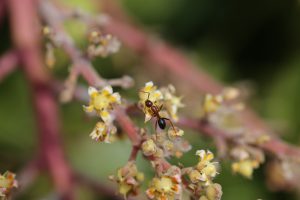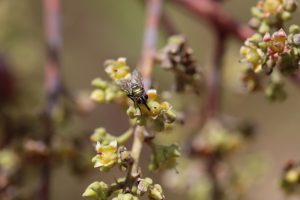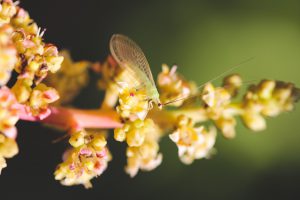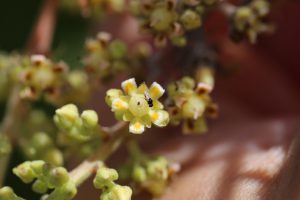The Impact of Arthropods on Pollination and Fruit Set of Keitt Mangoes
National Pollinator Week is a time to celebrate pollinators and spread the word about what we can do to protect them. The Tropical Fruit Entomology lab at TREC UF/IFAS has ongoing research on mangoes pollination.
Upon anthesis, wind and insects play an important role in the pollination of mangoes. The exact species of insects, however, is unexplored, and there is no connection between specific insects and the amount of pollen transported.

Photo credit: Matthew Quenaudon
In response to these issues, Matthew Quenaudon, a student at TREC UF/IFAS pursuing a Masters in Entomology, is working on different experiments constructed to investigate key insect families and species and the extent to which excluding arthropods affect mango pollination. The experiments dealt with signifying the most frequent visitors, determining the duration and interaction of insects with the flower structures, and excluding arthropods through mesh bagging.
Through these experiments, Matthew expects to provide a better understanding of the insects involved with ‘Keitt’ mango pollination, fruit set, and production in the Miami-Dade agricultural area. Increasing knowledge of the insects most associated with mango may provide a way for growers to increase their yield and fruit quality through means of increase pollination. If a few insects are highly associated with pollen distribution amongst mangoes, the same kind of study can be used with various tropical fruit production in the Miami-Date area. This type of information can be spread amongst growers with a focus on increasing these essential insects by reducing pesticide usage, allowing for natural plants and flowers to take hold throughout groves, and for farmers to be more aware of what insects are playing an important role amongst their crop.

Photo credit: Matthew Quenaudon

Photo credit: Matthew Quenaudon

Photo credit: Matthew Quenaudon

Photo credit: Matthew Quenaudon

Photo credit: Matthew Quenaudon
 0
0

Comments:
December 2, 2021
Thanks for this article. I'm in the starting phases of growing hemp here in swfl. I appreciate the insights! Kendra Solow @mindbodyphysique
November 6, 2021
This is great information for navigation through the details. The less confusion about the subject means more people finding a wonderful wellness product
November 5, 2021
looking to partner with any one to cultivate hemp. i had been doing row crops in homestead florida since 1989. i have my license, land and equipment. thanks. ganesh shivbaran. 3054840787
November 5, 2021
An excellent explanation of marijuana, hemp and what to beware of in the myriad CBD products now available everywhere. Good advice to read labels, select carefully and be suspicious of unregulated product claims - similar to all the food products which claim to be “organic “ and “non GMO.” Keep up the good work to educate John Q. Public!
November 5, 2021
Thank you for continuing to educate us in your field of expertise
November 5, 2021
Thank you Lisa, your commentary is very much appreciated.
November 5, 2021
Thank you for your work. ❤️ This is very well written and easy for anyone to understand.
July 27, 2021
Kenneth, I am copying Dr. Alan Chambers, the lead scientist on this research. He can help your comment/question. Alan, his comment was on the TREC blogs. Please reply. Kenneth is copied. This is interesting news. Is there any way of contacting Mr, Chambers directly. I am from Barbados in the Caribbean and am looking for a niche market product to grow on island. Thanks, bradbuck[at]ufl[dot]edu
July 23, 2021
Hi Alicia. Before you cut down your tree, you should notify FDACS-Division of Plant Industry (DPI) at 1-888-397-1517 and Jeff Wasielewski, Commercial Tropical Fruit Crops Agent, UF-IFAS Extension Miami-Dade County at 305-679-0227.
July 5, 2021
Based on the information and photos, my smaller lychee tree definitely has LEM. I’m a private homeowner, not a commercial grower. Should I contact the county and report this? The infestation is extensive and on 2/3 of the branches. Unfortunately, it seems my only recourse is to cut it down so it does not spread to my other tree.
June 28, 2021
I have read articles on new varieties of Vanilla plants being worked on by scientist Alan Chambers. This is interesting news. Is there any way of contacting Mr, Chambers directly. I am from Barbados in the Caribbean and am looking for a niche market product to grow on island.
May 14, 2021
Hi Al. Dr. Carrillo has requested you bring a sample to the Florida Extension Plant Diagnostic Clinic for further analysis. The Clinic is located at our campus, 18905 SW 280 Street, Homestead, Florida 33031. You can review the Clinic's website here: https://trec.ifas.ufl.edu/plantdiagnosticclinic/.
May 3, 2021
I have very tiny black insects, less than a cm long living on my litchee tree. They’re so tiny that’s it’s difficult to see them individually with the naked eye. They live in patches on the trunk. The patches, for lack of better description, look like black under arm hair. When disturbed they do not fly but continues to regroup like a herd. Are they harmful to my tree?
March 29, 2021
Hi Chan. Thank you for your inquiry. Dr. Carrillo has requested you visit this website for the most up to date information: https://trec.ifas.ufl.edu/Lychee-Erinose-Mite/. Thank you.
March 22, 2021
Thank you for your interest! The only document that we have available at this time is Matthew Quenaudon's master's thesis. You can find it here: https://ufdc.ufl.edu/UFE0054534/00001.
March 14, 2021
I have only just seen this on my lychee trees and the leaves are dying. It's spreading to other branches. My tree has only just started flowering. How do I get rid of this to avoid it taking over my entire tree? I have a younger one that's flowering for the first time and want to protect these so badly. Waited more than 10 years for the older one to flower. Help
February 23, 2021
Has this work been published? If so could you please provide a citation. Thank you
September 24, 2018
It is recommended that all infested branches are cut and burn before any acaricide treatment. Pruning is the most important cultural practice against the LEM and the most efficient way to remove infestations. After pruning, removing and destroying infested branches, acaricides can be used to protect new leaf flushes as they emerge and develop. Sprays applied directly to infested leaves and branches provide poor control because of the protection provided to the mites by the erineum. Among the acaricides registered for use in lychee in Florida, the only conventional pesticide registered acaracide proven to work against LEM in other parts of the world is Agri-Mek (abamectin). Agri-Mek is a restricted use pesticide (you must have a pesticide license to use this material) and has a restriction of a maximum two applications per year on lychee. Of the other insecticides known to have activity against LEM, azadirachtin, which is extracted from neem oil provides suboptimal control of this mite. Azadirachtin is labeled for use on lychee and can be used as an alternative acaricide while additional insecticides are being explored. Azadirachtin brand names include Aza-Direct, AzaGuard, Azatrol EC, and Trilogy. Although wettable sulfur has also proven efficacious against this mite, it is not registered for use on lychee at this time. Detailed control recommendations are available at: https://trec.ifas.ufl.edu/Lychee-Erinose-Mite/.
September 7, 2018
What can be sprayed on the tree to kill the invader ??
Comments are closed.